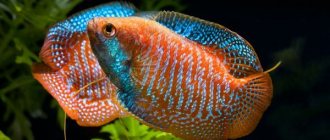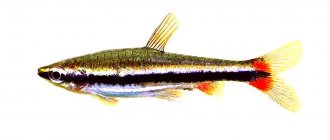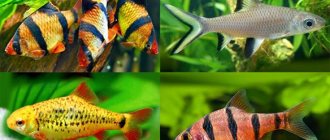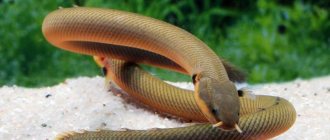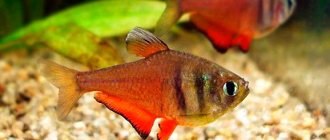Neon Green (Paracheirodon simulans) Gery, 1963.
It is not as popular as its two relatives, although it is also a very interesting and beautiful fish.
Synonyms
Russian: False Blue Neon, False Red Neon, Turquoise Neon, Blue Neon, Green Neon Tetra Latin: Cheirodon simulans, Hyphessobrycon simulans
Etymology
Paracheirodon: From the Greek para meaning "associated with", and the generic name Cheirodon. simulans: From the Latin simulans, meaning "imitation, copying."
Family: Characinaceae Genus: Neons
Range and Habitat
South America: Negro and Orinoco river basins.
Inhabits the Rio Negro basin in Brazil upstream of the mouth of its main tributary, the Rio Branco, plus the Rio Orinoco system in the Venezuela-Colombia border region, between San Fernando de Atabapo and the mouth of the Rio Meta.
The typical habitat is the Rio Jufaris, a tributary of the Rio Negro, located immediately after the latter's confluence with the Rio Branco in the state of Amazonas, Brazil.
Unlike its relatives P. innesi and P. axelrodi, this species is an exclusive inhabitant of black water and is found only in the upper reaches of tributaries.
Such habitat typically contains slow to moderate flowing water with dense, often overhanging riparian vegetation and sandy bottoms covered with fallen branches, tree roots and leaf litter.
The water is usually acidic, with little carbonate hardness and conductivity, and is brownish in color due to the presence of humic substances released during the decomposition of organic matter.
Although it occurs in the same range as P. axelrodi, the two species do not occur together, and P. simulans is usually found in warmer waters.
Fish Neon green, blue neon, blue neon, false red neon (Paracheirodon simulans)
Green Neon fish (Paracheirodon simulans) may also be known as blue neon, blue neon, false red neon. This aquarium fish is very easy to confuse with ordinary Neon, however, there are minor differences between them, but still. For example, green Neon has more modest dimensions: the length of the fish reaches no more than 2.5 cm. It is strongly recommended to keep these fish in schools (at least 7 individuals) in acidic and not hard water. It is very problematic to purchase this species, unlike, for example, Red Neons, however, all these species are very similar to each other, so even experienced aquarium holders confuse them.
Content nuances
Paracheirodon simulans are very active fish. Their character is peaceful, so they can be kept in the same aquarium with other species of fish of the Characin family. However, it is worth remembering that these fish are very shy, so they will be more comfortable if they are kept in an aquarium in schools of 10-20 individuals. This way they will feel less constrained, and fearfulness will be reduced to a minimum. In addition, it is in schools that fish reveal all the advantages of their appearance, standing out with their wonderful color against the background of everything else. It is highly not recommended to add other large aquarium inhabitants to blue Neons, since there is a real threat that the fish will simply be eaten.
Typically, False Red Neon chooses the lower and middle layers of water for its habitat. Those who intend to get these fish should pay attention to the choice of an appropriate aquarium: for one pair of Neons you need at least 15 liters of water.
The bottom and back wall of the aquarium should preferably be a muted dark color. It is also necessary to take care of the presence of various plants, including those floating on the surface of the water. Cryptocrines, Ceylon ferns, Echiodorus, duckweed and pistia are excellent for this purpose. The aquarium space can be decorated at your own discretion: caves, grottoes, pots and snags will make the environment for fish more diverse and interesting. Lighting is best done from above and not very bright.
Blue neons are very picky about water quality. So, the acidity of the water should be about 5-6 pH, and the temperature can vary from 22 to 26 degrees. It is also important to monitor the water hardness: it should not exceed 8 units. In an aquarium, it is desirable to have oxygen-saturated water, as well as round-the-clock filtration in it. It is also recommended to use a peat filter. In addition, every week it is necessary to change a quarter of the water in the aquarium with fresh water.
Neons are not picky eaters, so both dry and live food are perfect. It is best if it is some kind of small food: moths, frozen cyclops, larvae or daphnia.
Reproduction
Fish reach puberty at around 8-10 months. Neons usually spawn from October to January. It should be noted that breeding this type of aquarium fish is a complex and labor-intensive process that not everyone can handle. The first thing you need to do for this is to choose a suitable aquarium. The volume of such an aquarium for spawning should be approximately 20 liters, and the length should be at least 30 cm, and the back and side surfaces must be shaded: it is necessary to protect the aquarium from sunlight. The bottom can be lined with cryptocrine, Ceylon fern or Java moss. The water level in the aquarium should not exceed 20 cm, and the temperature should not exceed 26-27 degrees.
Before the actual spawning procedure begins, all producers must be kept apart for about 10-15 days. At this time, they need to be fed very generously with various types of food. Then they are moved to the prepared aquarium and stopped feeding. The spawning process usually begins early in the morning. If spawning does not begin within 2-3 days, it is necessary to replace the breeding fish with others.
Typically, during the spawning process, the female Green Neon leaves 20-250 eggs. After the spawning is over, the spawners are removed, and the spawning area is provided with complete darkness. The eggs will be incubated for 1-1.5 days and after 5 days tiny fry may appear and are already beginning their active life. During this period, they begin to gradually increase the illumination of the aquarium, which, however, still should not be too strong.
The fry must be fed with rotifers, live dust or ciliates. If all feeding conditions are met, the little Green Neons will begin to grow very quickly.
The average life span of these fish is approximately five years.
Where do they live?
In nature, this type of fish can be found in small rivers of South America without a stormy current. Also, the green Neon fish lives in the reservoirs of the Rio Negro River.
External data
False Red Neon has an elongated body that is slightly flattened on the sides. The caudal fin contains two blades, and the anal fin is slightly larger than the dorsal fin. The color spectrum of fish is extremely wide. The back of the fish starts with a dark green color and gradually becomes a lighter shade. A large black stripe runs along the body of the fish, tapering towards the tail. Also on this dark stripe you can see another sparkling blue one. The tail stem is red. There is a small, barely visible stripe on the anal fin. The male is smaller than the female, but boasts a more slender appearance. If all the necessary conditions in the aquarium are met, then males can live up to 5 years and reach a size of 3.5 cm.
Feeding
As already mentioned, green neon or blue neon is unpretentious in the choice of food: it can feed on everything it can swallow. However, it is recommended that the food be highly buoyant, as fish are more comfortable feeding from the surface of the water. To achieve the most beautiful coloring of green Neons, it is necessary to feed them as varied as possible, combining both live and frozen food.
Behavior of Blue Neons and who to keep them with
Blue Neons have a calm and peaceful nature, however, their small size can pose some problems when kept with other larger aquatic inhabitants. For example, it is not recommended to keep green Neons with angelfish, gouramis and large catfish, since these representatives can behave aggressively with them: it is best to breed representatives of the species Paracheirodon simulans in flocks of 5-10 individuals with small ornamental fish that do not exceed their size .
Description
Its body is slightly elongated and has a conical shape. The caudal fin is two-lobed, the anal fin is longer than the dorsal fin, and has a very small adipose fin.
The back is painted olive color. The red stripe present on the sides of the body below the blue-turquoise stripe is less bright, while the blue-turquoise extends from the eye to the base of the caudal fin.
Size:
The maximum standard length is 20 - 25 mm.
Appearance
Green Neon has a rather elongated body that is slightly compressed on the sides. The fin on the tail consists of 2 blades, and the anal fin is slightly larger than the dorsal one. The color of this fish is very diverse. The back is dark green, which gradually becomes lighter. A large black stripe extends throughout the body, which narrows as it approaches the tail. There is a small sparkling blue stripe on it. The tail stem is red. On the anal fin you can see a discreet small stripe. The male is smaller in size than the female, but has a more slender body. Under favorable conditions in an aquarium, it can live up to five years and grow up to 3.5 cm.
Behavior and Compatibility
Peaceful to other species, but not a suitable fish for the community aquarium due to its small size and somewhat specialized housing requirements.
Ideally should be kept separately in a species aquarium or, at most, with small, non-aggressive characins and smaller callichtid or loricariid catfish.
A schooling species, so buy as many as possible from 10 or more, since with this number the fish are more active and less timid, more often visible and have better coloring, and exhibit more natural behavior.
Diseases and prevention
With poor care, non-compliance with diet and stress, the fish’s immunity decreases and it begins to get sick.
The most common diseases:
| Name | Description |
| Plistophorosis | The fungal form is incurable. It manifests itself in refusal of food, swimming at an angle with the tail down, faded color, and incomprehensible behavior. |
| Ichthyophthiriasis | Contagious, spreads quickly. It is expressed by a white coating on the body in the form of semolina. |
| Dermatocystidiasis | Parasitic disease. It manifests itself in an advanced stage by the formation of a bubble with a pathogen in the gill area. |
| Saprolegniosis | The pathogenic mold fungus lives in every aquarium and begins to actively multiply in dirty tanks. On the fish it looks like a white ball of thin tangled threads. |
| Fin rot | A bacterial disease that is fatal to the fry. Adults experience it easier if the disease is detected at an early stage. It is expressed in the gradual destruction of the fins. |
| Obesity | A disease of many fish that occurs when the diet is not followed. It is easily treated with short-term diets. |
| Tuberculosis | A bacterial infection affects a group of fish. It is expressed by red swellings on the body. Very dangerous. |
Regardless of what symptoms are found in your pet, you should consult an ichthyologist. He will help you choose treatment and give recommendations on preventive measures for the rest of the aquarium inhabitants.
Aquarium
An aquarium with a base size of 45 * 30 cm or more is recommended.
It looks best when decorated in a natural style, consisting of sandy soil and driftwood - roots and branches or dense thickets of plants, while leaving areas free for swimming.
The lighting should be diffused; too bright light scares the fish; to dim it, let floating plants float on the surface of the water. You can add plants that can survive in these conditions, such as Thai fern, Java moss or Cryptocorynes.
Water parameters:
Temperature: 24 - 35° C; Temperatures in their natural habitat have been recorded in the range of 24.6-35.2°C, perhaps they have developed a natural tolerance to high temperatures. pH: 3.0 - 6.5 Hardness: 3 - 9° dGH (18 - 143 ppm)
Aeration with weak filtration, a quarter of the water should be changed weekly.
This species requires stable conditions, is sensitive to fluctuations or deteriorating water conditions and should not be introduced into an immature aquarium.
Maintenance and care
The content of green neons is not too difficult. You can place them in a small container, but a school of fish (10 - 30 individuals) in an aquarium with a volume of 150 - 200 liters with an abundance of living plants of red and dark green shades, dark soil and proper lighting makes an indelible impression. Neons are active fish and prefer to stay among plants. Very sensitive to the chemical composition of water. The water should be clean, slightly acidic (5.2 - 6.0) and soft. Air supply and water filtration through a peat filter are required. Neons do well if you replace a third of the water with fresh water once a week. You can add snow or rain boiled water if it is collected outside the city. Recommended maintenance temperature is 25 degrees. Allowable fluctuations should not exceed 2 - 3 degrees, otherwise the fish will get sick and quickly die.
Breeding
Breeding is considered very difficult.
To reproduce, they need water similar to what they live in in the wild; the water is very soft with a pH of about 6 and a temperature of about 25-26 ° C, with the addition of peat extract, creating the effect of black water.
The breeders are kept separately for two weeks; the fattest females and the most active males are selected for spawning. Spawning is either in pairs or in groups consisting of one or two males and several females, although it is worth noting that the more individuals involved, the greater the risk of eggs being eaten.
Spawning aquarium from 5-7 liters for a couple, the walls of which must be darkened. A separator net and pre-washed plants, for example Ceylon fern, are placed at the bottom. No lighting or filtration is needed, although you can install a small sponge air filter if you prefer.
About 130 eggs can be laid by each female. Parents must be removed after spawning. The eggs are incubated for 24 hours and are photosensitive, so avoid light. On day 4-5, the larvae swim and begin to feed. Fry should be fed with ciliates for the first 3-4 days, and as they grow they begin to be fed with Artemia nauplii.
Repeated reproduction is possible after a few weeks.
The first signs of coloration in juveniles appear on the 21st day. At the age of one and a half months, the juveniles already resemble their parents in body shape and color.
Life expectancy is about 5 years.
Features of reproduction
Neons reach sexual maturity by 6 months, and special conditions are required for their reproduction.
Sex differences
Neons have poorly developed sexual dimorphism. But you can distinguish a female from a male by its larger size and slight curvature of the strip on its side.
Preparing for spawning
Males and females are placed in different aquariums in advance and fed only live food for a month. All this time, the water temperature in the tank is maintained at 22 0C, and other parameters are kept as close to natural as possible.
Spawning
A separate 20-liter aquarium with a lid and an aerator that creates very fine bubbles is used as a spawning tank. It is better to lay a tangle of small fishing line, separator mesh or Java moss on the bottom of the tank. And to create moderate lighting, the walls of the aquarium can be covered with paper.
A 15-centimeter layer of distilled water is poured into the tank, the quality of which must meet the following indicators:
- temperature – 24-26 0C;
- acidity – 5-6;
- hardness – 1-2.
In the evening, future spawners are released into the prepared spawning area and given the opportunity to swim calmly. Spawning begins closer to dawn. The female lays up to 200 very small eggs, and the male, not lagging behind, follows her. When the process is completed, the fish are caught with a net and returned to the general aquarium.
The water level in the spawning tank is reduced to 7-10 cm, and aeration and lighting are completely removed, leaving only a small ray of light. To make it more convenient to control the eggs, the substrate is removed from the bottom of the aquarium.
Care of offspring
After 5 days, larvae emerge from the eggs. They rise to the surface to take in air and fill their swim bladder. The larvae feed on ciliates that have accumulated in the illuminated part of the aquarium, and after three days they become fry.
From this moment on, they switch to horizontal swimming and can already feed on Artemia nauplii, and later on small Cyclops.
The water in the aquarium with the fry is changed daily by a third of the total volume, gradually increasing its hardness. By the end of the first month, growing fish can be moved to a common tank.
Notes
As with all members of the genus, some wild specimens have varying numbers of golden-metallic scales and are sold as P. simulans "platinum" or "gold". Although this natural condition is said to be caused by a parasite that stimulates increased guanine deposition in the scales.
P. simulans can be distinguished from its relatives P. innesi and P. axelrodi by differences in color; it differs from P. innesi and P. axelrodi by having a greener (versus blue) lateral stripe that covers a larger (versus blue) smaller) part of the eye/head and extends to the base of the caudal fin (compared to the end of the front to the base of the caudal fin), a smaller (versus larger) amount of relatively duller (versus brighter) red pigmentation on the sides.

